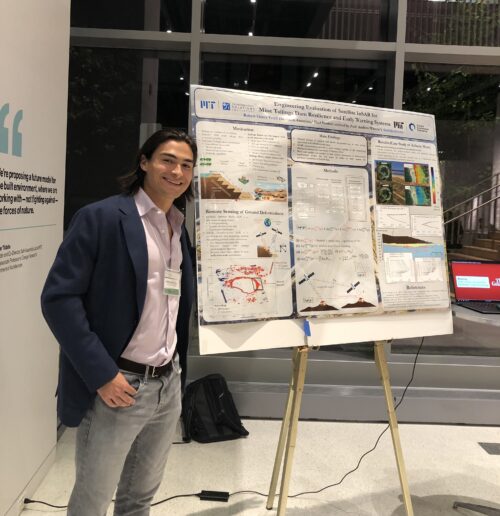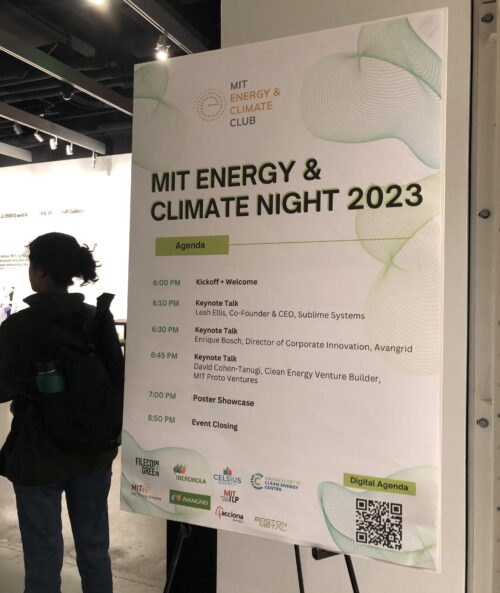Menu
ESI Stories
The ESI’s Rob Fetell Wins Best Poster at First MIT Energy & Climate Night
By: Sophia Apteker, Administrative and Communications Assistant
For 18 years, there was an annual MIT Energy Night. This year, for the first time, there was MIT Energy & Climate Night.
It was natural for the hosting MIT Energy & Climate Club (known as the MIT Energy Club before fall 2021) to weave climate into their flagship event. They have been delving into climate-conscious conversations at the leadership level for the past couple of years, something sparked by a trend in climate tech poster proposals first observed in 2019. Then, in 2020, the club began turning down fossil fuel funding to make its sponsorship money cleaner.
The name shift didn’t inherently change the makeup of the club or this event. It better reflected them.
“The kind of people who were interested in joining our club were both interested in energy and climate,” said Aaliya Hussain, a third-year MIT student who is one of MIT Energy & Climate Night’s managing directors. “We mainly rebranded to make it more inclusive and also cover the scope of what energy actually looks like today, which is a lot different than it looked like years ago.”
This transition was able to more obviously open the door to researchers like the ESI’s Rob Fetell to share their environmentally-focused findings.
Fetell’s presentation, titled “Engineering Evaluation of Satellite InSAR for Mine Tailings Dam Resilience and Early Warning Systems,” was awarded first place by attendee vote. The voting process was something that was also new this year, designed to give more of an active role to those passing through. A green ticket was given to each attendee at the door to vote for their favorite poster.

Rob Fetell with his first place poster. Photo credit: Sophia Apteker
His presentation explored how remote sensing can be used to improve transparency and safety in the mining industry. Currently, 18.3% of active upstream tailings dams report notable stability concerns, or a failure to confirm or certify stability at some point in their history, and the increasing frequency and severity of failure events is expected to continue. The primary technologies used, like embedded sensors (inclinometers, extensometers, and piezometers), are oftentimes unable to catch these failures. By providing 24-hour advance notice before a tailings dam failure — which Fetell’s InSAR technology hopes to do — it’s possible to reduce losses caused by these failures by as much as 30%. The same report also noted that a global investment of $800 million in early warning systems could prevent annual losses of $3 billion to $16 billion globally.
“It felt awesome to get the first place award,” said Fetell. “I have to admit, I was nervous at first, but every time I presented to a new group that came by, I could sense that my message was getting tighter and more engaging.”
Fetell was also particularly appreciative of his collaborators, including Alfredo Rocca at EO59 and Gonzalo Corral at Inteligencia Geotechnica, who guided him with SARProz post-processing software to understand the physics behind InSAR technology.

A close-up of Rob Fetell’s poster, courtesy of Rob Fetell, which can also be found here.
The night was studded with three keynote talks, 35 presenters, and upwards of 450 attendees.
Many of these attendees were MIT undergraduate and graduate students, but there were also a mix of individuals from universities in the Cambridge and Boston area, including Harvard, Northeastern, and BU. Eight students from The University of Texas at Austin also presented, tied to MIT through the Martin Trust Center.

MIT Energy & Climate Night featured three keynote talks and a poster showcase. Photo credit: Sophia Apteker
When it came to the event’s layout, the presentation topics were deliberately not sorted by sector.
“We wanted to have a random walk effect and encourage people to explore different areas of the space and demonstrate that in climate, in general, there aren’t distinct subgroups within the space,” said Hussain. “It’s not a solute environment inherently, and it should not be one.”
Other poster highlights included a system that used wall outlets to charge EVs, a multiple-occupancy solar electric vehicle, and a wind powered desalination system.
The event was coordinated by 11 MIT Energy & Climate Club members who were supported by the club’s co-presidents, as well as their finance, sponsorship, and marketing teams. The club has approximately 600 total members who are undergraduate, graduate, PhD, and MBA students.
“We have every department, and people come from different backgrounds,” said Shreyaa Raghavan, a PhD student who is one of the club’s co-presidents. “I myself am a computer science student, but we have people who are more business-oriented, more policy-oriented, more engineering or computer science oriented. I think that’s what makes this a unique space in terms of what kind of perspectives you can get from energy and climate.”
From Nov. 10-12, there will be the MIT Energy & Climate Hackathon. Like the Energy Night turned Energy & Climate Night, this hack will be the first climate-inclusive one of its kind.
“We have positioned ourselves as a hub on campus for energy and climate,” said Raghavan. “My main hope is that we continue that, and just grow bigger in terms of who we attract. I think that there are a lot of people who are interested in energy and climate broadly, even in their personal day-to-day life…but they think that it’s too niche of a club or you have to be ‘all in energy’ or you can’t join. I’d really like to make it an inclusive community for anyone who is even slightly interested in energy and climate, and help them find resources to push them in that direction.”
Learn more about Rob Fetell or the MIT Energy & Climate Club.















